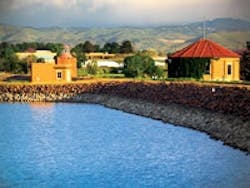About the author: Mary Beth Nevulis is associate editor for Water & Wastes Digest. Nevulis can be reached at [email protected] or 847.391.1025.
Mary Beth Nevulis
undefinedDenver, located at the foot of the Rocky Mountains and known as the “Mile-High City,” is served by three major water treatment plants (WTP): Marston, Foothills and Moffat. This triumvirate dates back to 1918, when Denver residents voted to buy the water system from the company that owned it. The entity created from that purchase, Denver Water, is a public agency funded by water rates and new tap fees—not taxes—and still is the utility that supplies water to the Denver area. Its service area covers more than 335 sq miles and provides potable water to 1.3 million people through a system of reservoirs networked by tunnels and canals.
One of Denver Water’s three major plants, the Marston WTP, was built in 1924 and expanded in 1967 with the construction of a second filter plant. Pretreatment was added in 1987. The original plant from the ‘20s was replaced by a new plant in 2003, and the 1967 filter plant was updated in 2010.
The current Marston plant features six flocculation/sedimentation basins, 16 dual-media filters with air scour backwash and a residuals-handling train consisting of a gravity thickener and belt filter press. The plant treats South Platte, Roberts Tunnel and Bear Creek water for distribution throughout the Denver metropolitan service area.
“Denver Water’s distribution system is completely integrated,” said Pete Muncaster, Marston WTP supervisor. “This means we can distribute water from any of our three potable treatment plants to anywhere in our system.”
Turning Up The Heat
In recent years, the Marston Plant has had to overcome some serious obstacles in order to ensure that high-quality potable water was getting to its customers. Those obstacles included two wildfires—one in 1996, which burned 11,900 acres, and another in 2002, which charred 138,000 acres of land and was the largest in Colorado’s history. The combination of these two fires, followed by significant rainstorms, resulted in more than 1 million cu yd of sediment in the Strontia Springs Reservoir.
“Increased sediment creates operational challenges, causes water quality issues and clogs treatment plants,” Muncaster said. “[And] protecting our source water is a vital part of ensuring high-quality drinking water. “
In 2010, the Marston plant began a partnership with the U.S. Forest Service, investing in a five-year project for restoration work on more than 38,000 acres of forests within area watersheds.
“There is a direct connection between healthy forests and sustainable supplies of clean water,” Muncaster said. “This work will help Denver Water regain capacity and water treatment operational flexibility for water quality.”
Dried Up
Like many other parts of the country, the Denver area is in its second year of a severe drought. The city’s reservoirs did not fill in 2012, and the mountain stream flows that feed those reservoirs are expected to measure well below normal this year as well.
“Based on the conditions we are seeing today, this may shape up to be Denver’s worst drought on record,” said Travis Thompson, media coordinator for Denver Water.
Because of this, Denver Water declared a Stage 2 drought, which means that customers may water no more than two days a week and must follow a set schedule.
Denver Water receives 80% of its water from the south end of the system, according to Thompson. This creates an imbalance that requires operational flexibility during severe droughts.
“We have to rely more heavily on the Marston and Foothills WTPs in the south end of our system, because we reduce operations at Moffat WTP to save water in the north end of our system,” Thompson said.
In times of drought, Denver Water also sometimes has to take water from sources it does not normally use, which can create more treatment challenges.
The Future
To increase the overall flexibility and reliability of the collection system, which will enhance operations of the treatment and distribution systems, Denver Water has proposed the enlargement of Gross Reservoir at the north end of the system.
“Since 1997, we have pursued a multi-pronged approach to increase supply and decrease demand through implementing an aggressive conservation plan, constructing a recycled water treatment plan and distribution system, and developing additional water supply,” Thompson said. “We have been successful in implementing the first two strategies and will continue to do so. But we also need to increase water supply, and enlarging Gross Reservoir is one of the major elements of our supply plan.”
Other projects on the horizon to upgrade the Marston WTP include closed transition electric upgrades to synchronize the emergency generators with the local utility’s power grid; complete replacement and upgrade of the flocculators and solids removal equipment; installation of a new equalization basin and treatment facilities for all waste streams; and construction of a new multilevel outlet works in Marston Reservoir.
Download: Here
